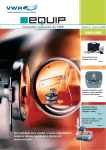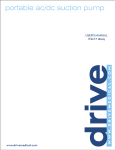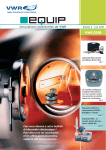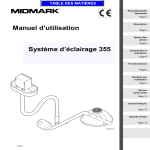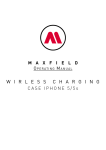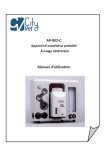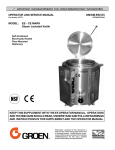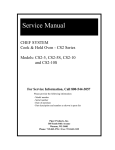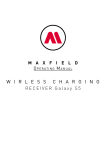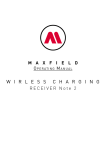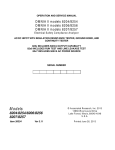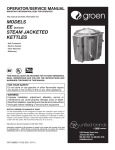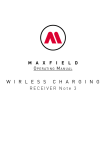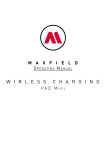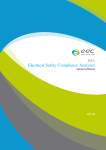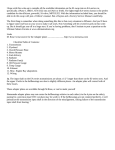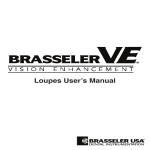Download Laboratory Biosafety Manual Biosafety Level Three Research
Transcript
Laboratory Biosafety Manual Biosafety Level Three Research Facility Utilizing Biosafety Level Three Practices for Work with Pathogen species Dr. John Doe Building B, Room R Phone 410.706.8888 [email protected] Department of School of University of Maryland Baltimore Approval Date: MM DD YYYY UMB SOP Final Template July 16, 2001 1 AUTHORIZATION TO USE THIS MANUAL Dr. John Doe; BL-3 Animal Work with Pathogen species Action . Scheduled manual review and update X Development of new policy and procedures Summary of Action The School of BL-3 Research Facility Operating Manual is a collaborative production with the Biosafety Division, Enviromental Health and Safety (EHS) and the University of Maryland Baltimore Institutional Biosafety Committee (IBC). All persons involved with research in this facility must read this manual. Authorized users of the facility will sign a sheet at the end of the manual to indicate that they have received the required training. Approvals of revisions to this manual are by this method. IBC #: ********** Approval signatures Chair, Institutional Biosafety Committee Date Biosafety Officer Date Director, Animal Services when appropriate Date 2 EMERGENCY CONTACT NUMBERS Flood, water leak, power outage Call Work Control (6.7570) and EHS (6.7055) during the day and University Police (711) during the evening. Fire Turn in a fire alarm and then call (711). Spill of mycobacteria outside containment Immediately inactivate the microorganism with 10% bleach. For major spills (greater than one liter) call (711) and EHS (6.7055). Personal exposure to Pathogen species by inhalation, cut, spill, etc. The steps to be followed are: Don’t panic. Do not breathe until you are clear of the contaminated area. Leave the area for 30 minutes. Wash site of exposure with a generous amount of tap water and soap. Flush eyes with water. Contact your supervisor and fill out a Employee First Report of Injury form. Take the completed Employee First Report of Injury form to Student and Employee Health, 29 South Paca Street (8.6791). (Hours of operation: Monday, Tuesday, and Thursday 8:30 a.m. to 6:45 p.m.; Wednesday and Friday- 8:30 a.m. to 4:30 p.m. For prompt medical treatment during clinic operating hours, follow this process: Page the Student and Employee Health Clinic at 410.512.0021. Advise them that you are an injured UMB employee. Describe nature of injury or illness. Arrange for an appointment to be seen at Student and Employee Health (SEH). Notify your supervisor of injury or illness. Complete the "Employee’s First Report of Injury" form (available from your department or Risk Management) and take with you to SEH. Distribute copy of completed form to supervisor. If there is NO response within 10 minutes: 3 Call Nurses Station "A" at SEH on (410) 328 0713 and request to speak with the Nurse Practioner. If the Nurse Practioner is not available, call the clinic Director at 410-328-2686 or page at 410-232-2668. MAJOR INJURIES or ILLNESSES 1. If serious or life threatening, contact the University Police by dialing 711. They will arrange for emergency response / transport. 2. Advise or have fellow employee advise your supervisor of situation. 3. Request that your supervisor complete "Supervisor’s Report of Injury" and fax it to Risk Management at (410) 706-1520. 4. When able, complete "Employee’s First Report of Injury" and fax to Risk Management at (410) 706-1520. Notify Risk Management if you are to be off work or on modified duty. Note: If employee is unable to initiate the above, the supervisor or co-workers should do so. 5. If injury or illness is not life threatening but requires immediate medical assistance, go to the UMMS Emergency Room , advise your supervisor promptly of your injury and follow steps 2 and 3, above. BLOODBORNE PATHOGEN EXPOSURE (NEEDLESTICK) If you are exposed to any human blood, blood products, bodily fluids or other infectious materials by direct contact, contact the NEEDLESTICK HOTLINE at (410) 328-2337, page number 7845. Report your name, type of exposure and that you are a UMB employee. Follow their instructions. This is a 24-hour per day 7 day per week service. Complete "Employee's First Report of Injury" and take it with you. Be sure a copy is sent to Risk Management as soon as possible after treatment. Information required for reporting an emergency to Student and Employee Health. Name and title of individual placing the call Date and time of accident/emergency Type of emergency Actual location of emergency - Building B, Room R, BSL-3 Research Facility Brief summary of events Cause of accident/emergency Injuries Contamination levels Immediate action taken Witnesses names and phone numbers 4 RESOURCES FOR PATHOGEN EXPOSURES EXPOSURE [NEEDLESTICK] HOTLINE 8-STIK 8-2337 pager 7845 During Working Hours: Student and Employee Health Clinic (SEH) 8-6791 29 South Paca Street Clinic Hours: Monday, Tuesday, and Thursday: 8:30 a.m. to 6:45 p.m. Wednesday and Friday 8:30 a.m. to 4:30 p.m. During Nights and Weekends: Physician on Call 8-2337 page 7845 General Resources: Ellis Caplan, M.D.,Chief Infectious Diseases MIEMSS 8-3656 Richard Colgan, M.D. Medical Director (SEH) 8.2686 J. Glenn Morris, M.D. Professor Epidemiology Infectious Diseases UMB 6-4580 James J. Jaeger, Ph.D. Biosafey Officer 6-7845 5 TABLE OF CONTENTS Authorization to use this manual Page 2 Emergency contact numbers 3 Resources for pathogen exposures 4 Table of contents 6 Introduction 7 Materials and chemicals kept in the BSL-3 research facility 8 Restricted use of the facility 9 Training requirements 9 Authorized facility entrance requirements 12 Routine operating procedures BSL-3 work practices and guidelines 12 Entry control 15 Medical surveillance 15 Personal protective equipment 16 Facility inspections 16 Containment barriers Diagram of the laboratory 17 Biological safety cabinets 18 Protection of laboratory vacuum systems 21 Transport of infectious materials 22 Waste disposal 22 Biohazardous and radionuclide spill control 23 Autoclave quality assurance program 25 Workers’ Compensation info for supervisors, managers, and administrators 30 6 INTRODUCTION The Research Facility at the University of Maryland Baltimore has been identified as a potentially hazardous work area due to Pathogen species research projects proposed to take place there. The NIH/CDC guidelines entitled Biosafety in Microbiology & Biomedical Laboratories, 4th Edition, dated May 1999, was used as a reference to make an assessment of an appropriate biosafety level for the Research Facility. Additional references include the University of Maryland Baltimore Safety Policies, and the NIH Guidelines for Research Involving Recombinant DNA Molecules (NIH Guidelines), dated January 5, 2001. All laboratory and animal handling procedures will follow the guidelines of Biosafety Level 3 (BSL-3) for the laboratory facility and Biosafety Level 3 (BSL-3) for practices. Because of the biohazards associated with Pathogen species research, all such operations will be confined to the designated research area. This document describes all standard operating procedures associated with the Research Facility. If questions remain, please contact the Biosafety Officer, at phone 6.7845. 7 MATERIALS AND CHEMICALS TO BE KEPT IN THE BSL-3 LABORATORY The following materials should be stocked within the BSL-3 Laboratory. Whenever the stock of any of the materials is low, it is the responsibility of the worker using that material to replenish the stock. 1. 70% Ethanol 2. Stock Bleach 3. 1:10 Bleach in plastic bottles 4. paper towels 5. pipettor pipette tips (all sizes) 6. colored, radioactive (if appropriate), and autoclave tape 7. polypropylene autoclave bags 8. radioactive waste containers (as needed) 9. large, medium, and small nitrile or latex gloves 10. plastic 1, 2, 5, 10, 25 cc disposable pipettes 11. plastic beakers and large graduated cylinders to hold bleach and decontaminated pipette tips and pipettes 12. polypropylene waste containers, double lined with autoclave bags 13. kimwipes, alcohol swabs 14. disposable and reusable gowns 15. HEPA respirators 16. mops, squeegees, buckets 17. forceps, scissors, rubber bands 18. plastic-bag lined biohazard boxes 8 RESTRICTED USE OF THE FACILITY As Facility Director, Dr. John Doe, has overall authority and responsibility for the laboratory. All research protocols must first receive appropriate institutional committee approval (Institutional Biosafety Committee, Institutional Animal Care and Use Committee, Institutional Research Committee, Radiation Safety Committee). Restrictions: All individuals working in the laboratory must be fully trained and approved as a capable handling the pathogen(s) being studied. TRAINING REQUIREMENTS Users will need to be certified as having appropriate BSL-3 facilities, BSL3 practices, and possibly BSL-3 animal research training. It is the responsibility of each Principal Investigator to ensure that all individuals working under his/her direction are appropriately trained for work with mycobacteria. Training of all personnel having contact with the laboratory will include procedures to be followed in the event of an emergency (e.g., fire, spills, etc.). A training program consisting of the items listed below has been developed by the investigators and approved by the Biosafety Officer. Each new approved user must sign a form, held by the principal investigator and EHS, certifying that he or she has undergone the training program and understands the facility procedures. There must be written documentation that safety training has taken place on the following subjects: A. Epidemiology and symptoms of Pathogen species. B. Explanation of transmission of Pathogen species. C. An explanation of procedures which may involve exposure to potentially infectious material. D. A discussion on selection, use, location, removal and disposal of personal protective equipment, including respirators if appropriate. E. Information on use and practices which reduce exposure, including engineering controls, work practices and personal protective equipment. F. Discussion of medical surveillance. 9 G. Discussion of hazard communication (i.e., signs, color coding, etc.). H. Discussion of Biosafety Level 2 & 3 work practices. I. Where appropriate, specific descriptions on handling animals infected with Pathogen species or other infectious agents. J. Specific experimental procedures used within the laboratory. After training, a certificate similar to the sample below, is to be signed by new employees. Copies of the certificate shall be filed with EHS and the Principal Investigator. 10 RESEARCH FACILITY TRAINING CERTIFICATION Check whichever is applicable: BSL-3 Facilities and BSL-3 Work Practices (non-animal) BSL-3 Facilities and BSL-3 Work Practices (animal) I certify that I have received training on use and handling of infectious agents, including Pathogen species. I have read and am familiar with the Laboratory Biosafety Manual, the University of Maryland Baltimore Safety Policies, and will follow all of the prescribed policies and guidelines. In addition, if I will be working with animals in the facility, I have received specific training on experimental procedures to use with animals, and have read and am very familiar with the Facility and Animal Biosafety Level 3 Guidelines in this Laboratory Biosafety Manual, supplied by my supervisor. Employee Signature Date Employee Identification Number Employee Print Name Supervisor Signature Date Biosafety Officer Signature Date 11 AUTHORIZED LABORATORY ENTRANCE REQUIREMENTS Keys and cards to the laboratory will be made available only through the principal investigator. Lost keys or cards must be reported to the principal investigator. Entry to the main entrance of the facility will be through Room R door in the B Building. Access to the facility shall be controlled by the principal investigator. An “Authorized Admittance” placard will be posted on or next to the entrance door, with the names and after-hours phone numbers of two individuals to be contacted in case of emergency. Individuals, must be trained in order to be permitted to handle Pathogen species infected materials within the laboratory. Employees handling such materials in the laboratory must first familiarize themselves with this manual, and sign a statement indicating that they are familiar with the procedures to be used in this facility and are also experienced in the handling of Pathogen species infected materials. Persons who may be at an increased risk of acquiring infection include those with open skin abrasions or sores which cannot be completely covered at all times and those with any respiratory deficiencies. Note: Authorized users will be expected to bear responsibility not only for their own work, but also for certain shared duties necessary to the smooth and safe operation of the facility. Thus, authorized users may be asked to supervise newly certified individuals, take part in periodic clean-up and inventory, serve on ad hoc committees, etc. A. DAYTIME ENTRY Only persons assigned to the laboratory may enter the area unless accompanied by the principal investigator or laboratory supervisor. Supervised routine cleaning shall be done by Housekeeping personnel and visits shall be coordinated with the principal investigator of laboratory supervisor after all contaminated areas have been decontaminated and all biological agents have been secured. When the CAUTION - RESTRICTED AREA sign is posed on laboratory equipment, or for entire work areas, mechanical failure of the equipment shall not be repaired until the hazardous agents have been removed; the equipment decontaminated, if required; and assurance given that the equipment can be safely repaired. EHS Hazardous Waste personnel will pick up infectious waste materials that have been autoclaved and placed in closed and sealed biohazard boxes. B. EVENING AND NIGHT ENTRY At the end of the working day the laboratory shall be “secured”. Infectious materials shall be stored in refrigerators, incubators, etc.; table tops shall be wiped down with an appropriate disinfectant; contaminated plasticware and glassware and equipment shall be decontaminated or in covered disposal pans to be placed in the autoclave. All hazard sources shall have been contained for the night. Facilities maintenance procedures, restricted during the working day, may be performed at night by arrangement with the principal investigator. 12 Emergency crews, and fire personnel may respond to emergencies in the area but may not enter unless the principal investigator, laboratory supervisor or EHS authorizes entry. ROUTINE OPERATING PROCEDURES All workers must follow the work practice guidelines established for BSL-3 by the U.S. Department of Health and Human Services/CDC and the National Institutes of Health Biosafety in Microbiological and Biomedical Laboratories, May 1999, and the NIH Recombinant DNA Guidelines, January 5, 2001, as modified by the Instututional Biosafety Committee. Specific procedures with changes, as outlined below, must be followed for work in this facility. BIOSAFETY LEVEL 3 WORK PRACTICES Biosafety Level 3 (BSL-3) is applicable to clinical, diagnostic, teaching, research, or production facilities in which work is done with indigenous or exotic agents which may cause serious or potentially lethal disease as a result of exposure by the aerosol route. Laboratory personnel have specific training in handling pathogenic and potentially lethal agents and are supervised by competent scientists who are experienced in working with these agents. All procedures involving the manipulation of infectious material are conducted within biological safety cabinets or other physical containment devices or by personnel wearing appropriate personal protective clothing and devices. No children under the age of 18 are permitted in the laboratory. The laboratory has special engineering and design features. It is recognized, however, that many existing facilities may not have all the facility safeguards recommended for Biosafety Level 3 (e.g., access zone, sealed penetrations, and directional air flow, etc.). In these circumstances, acceptable safety may be achieved for routine or repetitive operations (e.g., diagnostic procedures involving the propagation of an agent for identification, typing, and susceptibility testing) in laboratories where facility features satisfy Biosafety Level 2 recommendations provided the recommended “Standard Microbiological Practices,” “Special Practices”, and “Containment Equipment” for Biosafety Level 3 are rigorously followed. The decision to implement this modification of Biosafety Level 3 recommendations should be made by the laboratory director on advice of the Biosafety Officer. A specific facility operations manual is prepared, reviewed by the Biosafety Officer, and adopted by the IBC. The following standard and special safety practices, equipment and facilities apply to agents assigned to Biosafety Level 3 (BSL-3): A. STANDARD MICROBIOLOGICAL PRACTICES 1. Work surfaces are decontaminated at least once a day and after any spill of viable material. 2. Mechanical pipetting devices are used; mouth pipetting is prohibited. 3. Eating, drinking, smoking, storing food, and applying cosmetics or lip balm are prohibited in work areas. 13 4. Persons must wash their hands after handling infectious materials and animals, when they remove gloves, and when they leave the laboratory. 5. All procedures are performed carefully to minimize the creation of aerosols. B. SPECIAL PRACTICES 1. Laboratory doors are kept closed when experiments are in progress. 2. Contaminated materials that are to be decontaminated at a site away from the laboratory are placed in a durable leakproof container which is closed before being removed from the laboratory. 3. The laboratory director controls access to the laboratory and restricts access to persons whose presence is required for program or support purposes. Persons who are at increased risk of acquiring infection or for whom infection may be unusually hazardous are not allowed in the laboratory or animal rooms. The director has the final responsibility for assessing each circumstance and determining who may enter or work in the laboratory on advice of the Biosafety Officer. 4. The laboratory director establishes policies and procedures whereby only persons who have been advised of the potential biohazard and meet any specific entry requirements (e.g., vaccination, special training), and who comply with all entry and exit procedures may enter the laboratory or animal rooms. No minor children are allowed in the laboratory. 5. The approved hazard warning placard, incorporating the universal biohazard symbol, is posted on all laboratory and animal room access doors. The hazard warning placard identifies the agent, lists the name and telephone number of the laboratory director or other responsible person(s) and one additional contact person, and indicates any special requirements for entering the laboratory, such as the need for immunization, respirators, or other personal protective equipment. 6. All activities involving infectious materials are conducted in biosafety cabinets or other physical containment devices within the containment module. No work in open vessels is conducted on the open bench. 7. The work surfaces of biological safety cabinets and other containment equipment are decontaminated when work with infectious materials is finished. 8. Laboratory clothing that protects street clothing (i.e., solid front or wrap-around gowns, scrub suits, coveralls) is not to be worn outside the laboratory, and soiled clothing must be autoclaved before being laundered. 9. Vacuum lines are protected with high efficiency particulate air (HEPA) filters and liquid disinfectant traps. The vacuum source shall be independent from the building vacuum system. 10. Spills and accidents which result in overt or potential exposures to infectious materials are immediately reported to the Student and Employee Health Clinic and the laboratory director. Appropriate medical evaluation, surveillance, and treatment are provided and written records are maintained. 14 11. A specific facility operations manual is prepared, reviewed by the Biosafety Officer and the UMB Institutional Biosafety Committee, and adopted. Personnel are advised of special hazards and are required to read the manual and signify that they understand the practices and procedures by signing the manual. 15 MEDICAL SURVEILLANCE Medical surveillance will be coordinated with Student and Employee Health, 29 S. Paca Street, for approved users prior to their work in the laboratory. This may involve tuberculin tests, x-rays and respiratory surveillance programs. PERSONAL PROTECTIVE EQUIPMENT The following protective equipment must be used in the laboratory, and provided by each principal investigator for all authorized users working under their supervision: A. B. C. D. E. F. G. H. I. J. K. L. M. N. O. P. Q. Disposable, long sleeve, single-use gloves (multiple types and brands) of the appropriate size. Nitrile double gloving is recommended. Protective solid-front or wrap-around gowns, scrub suits, or coveralls. HEPA Respirator (ie., 3M Hepamate 12) when appropriate Foot coverings are optional Approved goggles or other eye protection. Multiple use utility gloves Protective laboratory clothing (solid front or wrap-around gowns with knitted or elastic cuffs) must be worn by workers when in the laboratory. Protective clothing is not worn outside the laboratory. Booties or shoe covers are optional. Two pairs of gloves must be worn when handling animals. Respirators and protective eye wear may be required. If respirators are worn individuals must be enrolled in the UMB respiratory protection program. Laboratory clothing must be removed prior to exiting the lab. All protective clothing must be donned inside the laboratory(s). It may be acceptable to put on clean, previously unworn protective clothing prior to entering the laboratory. Previously worn, clean protective clothing must be kept on hooks or bins inside the laboratory. Hands must be washed before and after removing personal protective clothing or equipment and again when leaving the laboratory. Certain articles of protective wear such as clear face guards may be decontaminated and stored for repeated use. No protective clothing may be worn outside the laboratory once it has been worn inside the laboratory. Disposable items of protective equipment shall be decontaminated by autoclaving immediately following completion of procedures. All others will be decontaminated appropriately utilizing an appropriate disinfectant. Other personal protective equipment may be made available to laboratory workers as deemed appropriate. 16 FACILITY INSPECTIONS Safety inspections will be conducted by EHS at least annually. These inspection reports will be kept on file with EHS, and will be available on request to the principal investigator and department chairman. EHS may inspect the facility at any time. Any violations noted during these inspections shall be corrected promptly. A written report outlining corrective actions must be sent to EHS within ten working days after receipt of a written report of an inspection. CONTAINMENT BARRIERS Attached is a diagram of the laboratory floor plan (R B) showing the layout and rough dimensions of the laboratory(s) where select agents will be handled or stored. Locations of the following are clearly marked on the floor plan: Entry and exit=D Air supply=A Exhaust vents=E Incubators=I Freezers=F Autoclaves=C Sinks=S Eyewash=W Emergency shower Biosafety cabinets=B Fume hoods=H H E B C F stations=M A 458 MSTF S I D M/W 17 BIOLOGICAL SAFETY CABINETS (BSC’S) Biological safety cabinets and any other special safety cabinets must have HEPA filters and flow rates checked and certified at least once every 12 months. 1. GENERAL SUGGESTIONS a. Keep your laboratory meticulously clean. Minimize storage of boxes and supplies particularly near a BSC. b. Wash your hands thoroughly before and after working in your BSC. Wearing a clean lab coat and gloves while working in a BSC increases your safety and helps reduce contamination of research materials. c. The effectiveness of the BSC is a function of directional airflow, inward and downward, through a high efficiency particulate air filter (HEPA). Anything that disrupts the airflow pattern reduces cabinet effectiveness, such as; rapidly moving your arms in and out of the BSC, people walking rapidly behind you, down-drafts from ventilation systems and drafts from open laboratory doors. d. Understand how your BSC works. Plan your work ahead. Protect yourself, your research and your coworkers. 2. STARTING UP THE BSC a. Turn off the ultraviolet (UV) germicidal lamp and turn on the fluorescent light, inspect the air intake grilles for obstructions and foreign materials. Remove any obstructions. Make sure the view screen window is adjusted (if adjustable) to the proper height. b. Turn on the blower motor and allow it to operate for at least five minutes. This purges the air from the internal BSC cabinetry. c. Wash your hands with soap. Put on a long-sleeved lab coat fastened in the front or rear and a pair (or two pairs, depending on procedure and agent being used) of high quality latex or nitrile gloves. Additional protection from contamination may be provided by wearing disposable sleeve protectors and a second or third pair of latex or nitrile gloves. “Street” clothing should not be worn when using a BSC. d. Disinfect the interior surfaces of the BSC by wiping down with appropriate disinfectant such as an iodophore (Wescodyne) or or 1:10 bleach. e. Place a plastic-backed “chux-pad” or bench liner on the dry, disinfected work surface of the BSC. Avoid covering the air intake/exhaust grilles. f. Install all necessary items for your experiment in the BSC at this time. Keep clean items segregated from dirty items. Minimize the amount of equipment and supplies; overloading the working zone with equipment and supplies may compromise the effectiveness of your BSC. Organize your material so that dirty “contaminated” items are not passed over clean items. Work from “clean” to “dirty” areas. A good work layout of materials would position clean items, i.e., pipettes, cultures, flasks, etc. toward the front or either side of the work surface. Place your waste container and contaminated pipette trays to the rear. You should work at least six inches back from the front of the air intake grille. g. If you are using a vacuum flask system in your BSC, put a vacuum protection device, a hydrophobic filter, in line to protect the vacuum system. 18 h. After all equipment and supplies are added to your BSC, allow it to operate for an additional three to four minutes. This will allow the BSC to purge itself of airborne contaminants. i. Assume a comfortable seating position in front of the BSC. Your chair should be adjusted to a comfortable height that promotes ergonomic posture. When inserting your arms into the BSC remember that they are penetrating a delicate “curtain” of air. Allow the air curtain to stabilize around your arms before starting work. Avoid making rapid, jerking arm motions. Use smooth motions that avoid disrupting the air curtain. j. Remember that the BSC air curtain is delicate and can only provide protection from contamination as long as it is not disrupted. The BSC is not a substitute for good microbiological practices and does not automatically provide you with protection from potentially hazardous materials or automatically prevent contamination of the experimental and materials. k. Follow good microbiological techniques, i.e., holding open tubes and bottles as horizontal as possible. 1) Never mouth pipette. Use mechanical pipetting aids. 2) Do not use vertical pipette discard canisters or baskets on the floor next to the BSC. Use horizontal pipette discard pans inside the BSC. 3) It is not necessary to flame items. The flame creates turbulence in the airflow and will compromise sterility. If the lip of a tube or flask is wet, an aerosol may be created when the lip is flamed. Additionally, heat buildup can also damage expensive HEPA filters. Unattended burner pilot lights have created extensive fire damage to BSC’s and sometimes entire laboratories. l. If you need to introduce new items or remove items from the BSC, move your arms in and out slowly to minimize airflow disruption. m. If you use equipment that creates air turbulence,i.e., centrifuge, blender, or sonicator, place the equipment as far back in the BSC as possible (usually 1/3 of the way back from the front intake grill is acceptable). Stop other work while the equipment is operating. n. Clean up all spills inside the BSC immediately and then wait 3-5 minutes before resuming work, if your laboratory operating procedures allow. o. An externally mounted drain valve is located under the drain pan of many BSC’s. In the event of an accidental spill, you can remove large volumes of disinfected, spilled materials froPathogen speciesnder the work surface. The drain valve is not to be connected to a sink or similar drain. A bucket can be used to collect any spilled liquid for decontamination and disposal. 3. CLEANING THE BSC a. When work has been completed, disinfect the exterior surfaces of potentially contaminated materials and supplies with appropriate disinfectant before removing them from the BSC. Remove all materials from the interior of the BSC. b. Disinfect the interior BSC surfaces, including the inside of the view screen, with an appropriate disinfectant solution. 19 c. Allow the BSC to operate an additional 10 minutes, then turn the blower motor off. Caution; do not close the view screen when the blower is on, the view screen may crack or shatter. Note: Some BSC users prefer to leave the blower motor on continuously. This is a permissible practice. However, service life of your HEPA filters will be reduced. d. Examine the spill pan beneath the work surface. Clean and disinfect the spill pan as necessary. We recommend that the spill pan beneath the work surface be cleaned on a four times per year. Be careful when removing interior work surfaces. They are heavy and may have sharp edges and corners. Consult your service manual for proper removal/maintenance procedures. e. Do not clean the spill pan when a BSC is operating. Paper towels may be accidently sucked into the airstream and can lodge in the blower motor and HEPA filter. Recovering paper towels can only be accomplished by BSC disassembly via an authorized service technician. Do not attempt retrieval yourself. Contact the Biosafety Officer for service. f. Turn off the fluorescent lamp and turn on the ultraviolet germicidal lamp if so equipped. g. Discard waste materials appropriately (autoclave, red bag trash, etc.). h. Remove your lab coat and gloves and then wash your hands thoroughly. 4. FLAMMABLE OR EXPLOSIVE MATERIALS WITHIN BSC’S Standard electrical systems of Class II BSC’s are not explosion proof. No flammable or explosive materials (chemicals, cleaners, or solvents) should be used in a BSC. Most BSC’s are labeled with a warning sign on the front face of the cabinet warning against the use of flammable or explosive materials within it. Refer to your owners manual or call EHS for proper guidance. Under no circumstances should a chemical’s vapor concentration be allowed to approach its level of flammability. Each BSC type has its own ventilation characteristics. Remember, in the absence of a canopy exhaust duct connection, a BSC’s air is recirculated within the laboratory. This can return a vapor or gas contaminant back to the “clean” work space until equilibrium is reached. Standard BSC HEPA filters are made of fiberglass and do not remove chemical contaminants from the air. A chemical’s equilibrium concentration level depends on the vapor or gas generation rate at the work space and the air exchange characteristics of the BSC and the laboratory facility. HEPA filters remove only particulates. Gases and vapors will readily pass through HEPA filters and must be controlled by other methods. When planned work involves chemical carcinogens or solvents, it is necessary to evaluate the quantities to be used to determine the amount that might be entrained in the BSC air stream during an accident. 20 PROTECTION OF LABORATORY VACUUM SYSTEMS Vacuum filtration or aspirating supernatants into collection flasks are common laboratory procedures. During vacuum filtration or aspiration procedures building/laboratory vacuum systems should be protected by use of an aerosol and fluid filter (eg., VacuGuard Disposable Filter/Whatman). A simple bench-top aerosol/fluid trap can protect building/laboratory vacuum systems. The basic vacuum trap consists of a disposable cartridge-type “hydrophobic filter” or equivalent installed in-line with a collection/overflow vacuum flask system. Contact the Biosafety Officer for more information. The aerosol/fluid trap consists of two vacuum flasks, preferably plastic, (size dependent on amount of fluid that may accidentally be aspirated out of the collection flask), thick walled tubing (to prevent tubing collapse), rubber stoppers, a hydrophobic filter (prevents unwanted potentially biohazardous fluid and aerosols from entering vacuum systems), and a ceramic sparger (ceramic fish tank bubbler) immersed in disinfectant. The sparger disperses aerosols passing out of the collection flask into small bubbles so that adequate contact is made with a disinfectant solution. Use an appropriate disinfectant solution effective on any biohazardous material under study. It is essential that antifoam spray be added to the overflow flask since air bubbling through the disinfectant-immersed sparger will produce foam which may shut off the vacuum if allowed to clog the hydrophobic filter. If the hydrophobic filter or overflow flask require routine changing, they can be safely removed by clamping the line between the filter and the vacuum source before disconnecting the tubing from the source. EHS recommends that the filter and vacuum flask be decontaminated by autoclaving. 21 TRANSPORT OF INFECTIOUS MATERIALS Culture stocks, infectious blood products or infectious cell lines will be transported in shatterproof, leak proof, double-walled containers, such as the “Playmate” line of lunch boxes. They will be transported by the least congested route. WASTE DISPOSAL All waste must be decontaminated before leaving the facility. In general, liquid waste must be decontaminated with an iodophore, 1:10 bleach, or an alternative disinfectant approved by EHS. Microbial cultures and solid waste must be autoclaved. Animal carcasses must be double bagged, tagged, and discarded into the approved, plastic bag-lined EHS biohazard box or EHS gray carts. All culture-contaminated disposables will be autoclaved immediately following completion of the work. All autoclaved solid waste shall be discarded into the approved, plastic bag-lined EHS biohazard box or EHS gray carts. Plastic backed paper liners will be used on counters for any operations involving infectious agents, and then replaced after use or excessive contamination. The papers will be placed in autoclave bags, autoclaved immediately following use, and discarded into the plastic bag-lined EHS biohazard box or EHS gray cart. Approved plastic sharps containers for “sharps” disposal shall be closed and autoclaved when ¾ full. Autoclaved containers shall be discarded into the plastic bag-lined EHS biohazard box or EHS gray cart. To limit the potential for accidents, no glassware will be allowed within the facility without the special consent of the Principal Investigator. All microbial culture-contaminated solid materials must be placed in polypropylene autoclave bags and autoclaved. Non-microbial culture-contaminated culture medium, flasks, test tubes, pipettes, etc. containing liquid will be decontaminated with an appropriate disinfectant, drained into the sanitary sewer system, and discarded into a plastic bag-lined biohazard box. Autoclave bags should be closed at the work site and a strip of “autoclave tape” with chemical indicator should be placed on the outside of each autoclave bag. Each pan containing an autoclave bag should be placed into the autoclave chamber and decontaminated. After decontamination and when needed, long handle tongs should be used to transfer each autoclave bag to a plastic bag-lined EHS biohazard box or EHS gray cart for pickup by EHS Hazardous Waste Division (6.7207). At no time should filled biohazard boxes remain in the area. 22 BIOHAZARDOUS SPILL CONTROL A. LARGE SPILL OUTSIDE OF BSC 1. Do not breathe, leave the room immediately, and close the door. 2. Notify supervisor and warn others not to enter the contaminated area. Post an EHS approved temporary warning sign. 3. Remove and put contaminated garments into an autoclave bag-lined container for autoclaving and thoroughly wash hands and face. 4. Wait 30 minutes to allow dissipation of spill-created aerosols by the room ventilation air changes. 5. Put on a long-sleeve gown or a jump suit with elasticized wrist and ankles, respirator, and rubber gloves before reentering the room. 6. Pour an appropriate disinfectant solution (1:10 household bleach) around the spill and allow it to flow into the spill. Paper towels soaked with the disinfectant may be used to cover the area. To minimize aerosolization, avoid pouring the disinfectant solution directly onto the spill. 7. Let stand 20 minutes to allow an adequate contact time. 8. Using a dust pan and squeegee, transfer all contaminated materials (paper towels, glass, liquid, gloves, etc.) into an autoclavable bag in a deep autoclave pan. Broken glass and sharp items are to be picked up with a forceps. Cover the pan with a suitable cover and autoclave according to standard directions. 9. The dust pan, forceps and squeegee should be placed in an autoclave bag and autoclaved according to standard directions. Contact of reusable items with nonautoclavable plastic should be avoided—separation of the plastic after autoclaving can be very difficult. 10. Wash and mop adjacent area and spill area with appropriate disinfectant detergent solution. 11. Remove and discard protective clothing. Shower with a germicidal soap. B. 1. 2. 3. 4. SMALL SPILL OUTSIDE OF BSC Do not breathe. Leave the area for 30 minutes. Cover spill with paper towels. Flood spill with appropriate disinfectant using care not to cause spatter. Add disinfectant slowly to outer margin of spill and allow it to flow in. Allow disinfectant to act for 20 to 30 minutes before cleaning up with more paper towels. Discard materials (paper towels, gloves, and other wastes from clean-up into an autoclavable bag in a plastic container and autoclave. C. RADIOACTIVE SPILL OUTSIDE OF BSC In the event that a biohazardous spill also involves a radiation hazard, the clean-up procedure may have to be modified, depending on an evaluation of the risk assessment of relative biological and radiological hazard. Laboratories handling radioactive substances must have the Radiation Emergency Procedures available for consultation. 23 The following procedure indicates suggested variations from the biohazard spill procedure (above) that should be considered when a radioactive biohazard spill occurs outside a Biological Safety Cabinet. 1. Do not breathe, leave the room immediately and close the door. 2. Notify supervisor and warn others not to enter the contaminated area and to post the EHS-approved temporary warning sign. 3. Remove and put contaminated garments into an autoclave bag-lined container for autoclaving and thoroughly wash hands and face. 4. Wait thirty minutes to allow dissipation of spill-created aerosols by the room ventilation air changes. 5. Before clean-up procedures begin, Radiation Safety personnel must survey the spill for external radiation hazard to determine the relative degree of risk. 6. Put on a long-sleeve gown or a jump suit with elasticized cuffs, respirator and rubber gloves before reentering the room. 7. Pour an appropriate disinfectant solution (1:10 household bleach) around the spill and allow it to flow into the spill. Paper towels soaked with the disinfectant may be used to cover the area. The minimize aerosolization, avoid pouring the disinfectant solution directly onto the spill. 8. Let stand 20 minutes to allow adequate disinfectant contact time. 9. If energetic beta or gamma emitters are involved, care must be taken to prevent hand and body radiation exposure. The Radiation Safety Officer must make this determination before the clean-up is begun. a. If Radiation Safety approves, the biohazard-handling procedure may begin: Using an autoclavable dust pan and squeegee, transfer all contaminated materials (paper towels, glass, liquid, gloves, etc.) into an autoclave bag inside a deep autoclave pan. Autoclave according to standard directions. Autoclave the dust pan, squeegee, and possibly forceps in a prepared autoclave bag-lined pan. b. If Radiation Safety determines that radioactive vapors may be released and thereby contaminate the autoclave, the material must not be autoclaved. In that case, sufficient bleach solution to immerse the contents should be added to the waste container. The cover should be sealed with waterproof tape, and the container stored and handled for disposal as radioactive waste. Radioactive and biohazard warning symbols should be affixed to the waste container. As a general rule, autoclaving should be avoided. 10. A final radioactive survey should be made of the spill area, dust pan, and squeegee with a Geiger counter, or a smear should be taken and counted in a liquid scintillation counter. D. SPILL OUTSIDE THE RESEARCH FACILITY Handle as a small or large biohazardous spill, whichever is appropriate. Call your supervisor and EHS. 24 AUTOCLAVE QUALITY ASSURANCE PROGRAM FOR DECONTAMINATION The autoclave must be maintained on a quality control program outlined below. The log book must be kept next to the autoclave. I. OBJECTIVES To establish guidelines for the effective use of steam autoclaves and to protect personnel and the environment from potentially infectious materials and waste. To meet the waste disposal requirements of the State of Maryland, AAMI, AHA, CDC, and UMB/UMMC. Background: The following basic guidelines should help you develop your own departmental autoclave quality assurance program for monitoring autoclave decontamination effectiveness. Effective quality assurance includes: using chemical and biological indicators to check autoclave operation; selecting appropriate containers to hold waste while being decontaminated; using effective decontamination processing times for each load; maintaining proper autoclave use records; providing odor control when necessary; and providing personnel training for the operation of an autoclave. Use of steam sterilizers (autoclaves) should include validation of decontamination effectiveness. Validation of effectiveness includes monitoring temperature, pressure and cycle duration time for each cycle and providing periodic decontamination challenges (quality assurance), i.e. use of biological indicators. A logbook should be maintained to record autoclave use. The logbook should be available for inspection by various agencies and authorities. II. INDICATORS A. CHEMICAL INDICATORS 1. Chemical Color Change Indicators: Chemical indicators for steam autoclaves change color after being exposed for a few minutes to normal autoclave operating temperatures of 121oC (250oF). Hence, chemical indicators can give you a quick visual reference for heat penetration inside the load. Chemical indicators should be positioned near the center of each load, and toward the bottom front of the autoclave. CAUTION: Most chemical indicators can only be used to verify that your autoclave reaches normal operating temperature for decontamination, 121oC (250oF); they have no time factor. Chemical indicators alone are not designed nor intended to prove that organisms are actually killed during a decontamination cycle. Where to Purchase Chemical Indicators: Chemical indicators are manufactured by many companies and come in a wide variety of sizes, shapes, and colors. Some examples are: “Dualchek and Single Indicators” 25 BAXTER, “Test-A-Clave” - BAXTER, “ATI Indicator Tape” - Thomas, “ATI Sterilometer-Plus 250” - Thomas, “Sterikon-Bioindicator” from EM - VWR, and “TSI Time Indicator” - VWR. 2. Tape Indicators: Tape indicators are adhesive backed paper tape with heat sensitive, chemical indicator markings. Commonly used heat sensitive markings include diagonal stripes (autoclave tape), and/or the word “sterile”. These markings only appear when the tape has been exposed for a few minutes to normal autoclave decontamination temperatures. CAUTION: Tape indicators can only be used to verify that the autoclave is reaching normal operating temperatures for decontamination, 121oC (250oF). Tape indicators alone are not designed nor intended to prove that organisms have actually been killed. Tape indicators should be used on all material decontaminated by autoclaving to show that the material has been processed. A three to four inch strip of autoclave tape placed on the outside of the autoclave pan, bag, or individual container is sufficient. B. BIOLOGICAL INDICATORS Biological indicator systems are designed to demonstrate that an autoclave is capable of killing microorganisms. Only Bacillus stearothermophilus spores can be used to monitor the effectiveness of steam autoclaves once a week. Typical biological indicator systems consist of a vial with spore strips or a small glass ampule of growth medium with spores and indicator dye. Refer to manufacturers’ instructions for use. The biological indicator is removed from a load after it has been autoclaved. Then, the biological indicator is incubated at 56oC for up to three days. Your control vial, that was not autoclaved, should be turbid after incubation; the successfully decontaminated test vial should remain clear without evidence of turbidity (no growth). If the autoclaved biological indicator is turbid (cloudy, indicating growth) the autoclave did not function properly. Notify your area supervisor when this happens. WHERE TO PURCHASE BIOLOGICAL INDICATORS: Some manufacturers of biological indicators have incubators available to fit their vials. Some examples of biological indicators are: “Duo-Spore Biological Indicator; VWR Catalog # 15425-032. III. CONTAINERS Materials that are to be decontaminated should be carried to the autoclave in closed, leak proof containers. Containers used to hold material while being autoclaved are described below. 26 A. SECONDARY CONTAINERS 1. Plastic Containers: Polypropylene is a durable inexpensive plastic resin which is commonly used contain material during autoclaving. Polypropylene plastic pans with 6-12 inch sides are favored over polyethylene and polystyrene because polypropylene can withstand autoclaving without melting. Note: When using polypropylene containers, add extra processing time to the autoclave decontamination cycle because polypropylene does not conduct heat well. 2. Stainless Steel Containers: Stainless steel containers are durable and come in a variety of sizes and shapes. Because stainless steel is a good conductor of heat, autoclave decontamination cycle processing time may be reduced. Where waste containment is mandatory, stainless steel containers may be the container of choice because it is durable. Restaurant supply companies are a good source for these pans. B. PRIMARY CONTAINERS Plastic Autoclave Bags: Polypropylene bags are used to contain materials during decontamination cycles within autoclaves. Also known as “biohazard bags”, “autoclavable bags”, or [VWR bags, bio check] come in a wide variety of sizes, shapes and colors. Autoclave bags are usually placed in polypropylene or stainless steel pans during decontamination cycles to catch liquids that may drain out of the bag. Autoclave bags must be left open during decontamination procedures to allow steam to penetrate into the bag. Additional water should be added to the bag’s interior to facilitate heat transfer to the items being decontaminated. The amount of extra water added to the bag should be determined experimentally by the autoclave user, based upon the type and size of material being decontaminated. IV. GENERAL AUTOCLAVE OPERATION CAUTION: Only personnel with adequate training on autoclave use should be permitted to operate an autoclave. Personnel should wear proper personal protective equipment, ie. heat resistant gloves, eye protection, etc. particularly when unloading the autoclave. Regularly inspect your autoclave components for proper operation. Autoclave door clamps and seals should be inspected for wear and damage. Also remove debris from the autoclave chamber floor drain. If a problem is found, promptly notify your area supervisor who will call an authorized service representative. DO NOT OPERATE THE AUTOCLAVE UNTIL IT HAS BEEN REPAIRED PROPERLY. 27 At the end of a decontamination cycle make sure that the pressure in the autoclave chamber is near zero before opening the door. Slowly crack open the autoclave door and allow the steam to gradually escape from within the autoclave. CAUTION: Opening the autoclave door too quickly may result in glassware breakage and/or steam burns on your skin. The decontaminated materials should be allowed to cool for 10 minutes before they are taken out of the autoclave. THINGS TO AVOID: Avoid dead air pockets where steam cannot penetrate (ie., closed screw cap tubes) because temperature within the air pocket is much lower than the saturated steam. Avoid dry packages, add some water to the load. To avoid creation of infectious aerosols while adding water, trickle water down the sides of the container instead of pouring water directly onto the material in the container. A. PROCESSING TIMES: After loading and starting the autoclave, processing time starts after the autoclave reaches normal operating conditions: Temperature = 121oC (250oF); Pressure = 15 psi. Decontamination conditions vary, i.e. type of load, load volume (loose packed or tightly packed), container type (polypropylene, glass, stainless steel), and type of material to be decontaminated. Therefore, processing times will vary according to the conditions of each decontamination cycle. In general, the larger the load, the longer it will take to decontaminate. The processing time to decontaminate lab and medical waste is at least 60 minutes (unless a shorter interval has proven effective when tested with biological indicators). Add additional time if polypropylene containers are used. A minimum of at least 90 minutes is recommended for decontaminating waste in low sided polypropylene containers with bags half filled and loosely gathered. If bags are tightly closed, a processing time of 120 minutes is recommended. If your autoclave is equipped to operate at 132oC (270oF), you may be able to reduce processing time if the Bacillus stearothermophilus spores are killed at the shorted cycle time. B. SUGGESTED AUTOCLAVING TIMES A minimum decontamination processing time of 60 minutes is recommended for materials in metal pans with the lid removed. The US Environmental Protection Agency (EPA) has reported that.....”Infectious wastes from departments of health care facilities may be rendered noninfectious by subjecting the waste to autoclave temperatures of 121oC (250oF) and 15 minutes of prevacuum of 15 psi for the following dwell times when proper containers are used:” 28 EPA Recommended Decontamination Processing (Dwell) Time ITEM TRASH GLASSWARE LIQUIDS ANIMAL CARCASSES ANIMAL BEDDING DWELL TIME 60 Minutes 60 Minutes 60 Minutes / Gallon DO NOT AUTOCLAVE 120 Minutes V. ODOR CONTROL Some waste material has an extremely noxious odor, i.e. anaerobic bacteria, feces or decaying organic materials. When decontaminating these materials it may become necessary to add an odor control additive to the load. A scoopfull of unused animal bedding (cedar shavings) works quite well. These additives may produce chemical exposure symptoms for some people. VI. TRAINING It is imperative that supervisors provide training to qualify their staff for the use of steam autoclaves to decontaminate materials. Qualified autoclave users should understand the time, temperature, pressure relationships required for proper materials decontamination. Additional training on handling materials to be decontaminated should also be provided. Supervisors should maintain a permanent record of training provided to their staff. Additional training support on the effective use of steam autoclaves is available from the EHS. For assistance, call the Biosafety Officer at 6.7845. VII. RECORD KEEPING A durable note book should be used as a permanent record of autoclave use. The autoclave log book should be located in an easily accessed location near the autoclave. The autoclave log book should have at least the following information entered: Autoclave Manufacturer Department Date Log Book Started Materials Processing: Autoclave Serial Number Room Location Maintenance Work Done The main section of the autoclave record should have a log including: Autoclave User, Date Used, Materials Decontaminated, Process Type, Run Duration (Cycle Time), Chemical/Biological Indicator Used, Chemical/Biological Indicator Results, Envelope for “Wheel Graphs” or “Data Strips”. 29 WORKERS’ COMPENSATION INFORMATION (for Supervisors/Managers/Administrators) 1. WHAT PROCEDURE SHOULD YOU FOLLOW IF ONE OF YOUR STAFF REPORTS THAT HE/SHE HAS BEEN INJURED ON THE JOB ? Speak briefly with the employee to determine the severity of the injury and the circumstances surrounding the incident. • • • • • • • • • If the work-related injury or illness is determined to be of an emergency nature, the employee should receive treatment at the Hospital’s Main Emergency Department. In the event that an employee requires medical assistance at the scene of the incident or needs to be transported to the Main Emergency Department by medical personnel, call: The University Police (711). For non-emergency injuries, send the employee to Student and Employee Health for treatment at 29 South Paca Street (8.6791). The hours of operation are Monday, Tuesday, and Thursday, 8:30 a.m. to 6:45 p.m.; Wednesday and Friday from 8:30 a.m. to 4:30 p.m. During hours when the Clinic is closed, call the Needlestick Hotline (8.2337 pager 7845) if a bloodborne pathogen exposure, otherwise seek medical attention at a medical facility. If the employee can be moved and transported safety by non-medical personnel, he/she should be accompanied by a supervisor or co-worker to the appropriate health care facility (Student and Employee Health Clinic or Emergency Department). A University Police Officer may be called for assistance (711). A “Employee First Report of Injury” form must be completed by you or your designee at the time the employee reports the incident. The first copy (white) and the second copy (yellow) should accompany the employee to the treatment location. The third copy (pink) is retained for department files. If you are unable to complete the Employee First Report of Injury at the time of the injury, a call from you to Student and Employee Health (8.6791) is required to identify the employee and the department. Briefly explain the injury and identify it as work-related. If an Employee First Report of Injury is not completed at the time of the injury, a report should be completed as soon as possible following the incident. The first two copies should be forwarded immediately to the Student and Employee Health Clinic. Even if the reported injury or illness is not serious enough to require treatment, an Employee First Report of Injury should be completed and sent to the EHS (714 W. Lombard Street). If follow-up care is necessary, that care will be scheduled and received at the Student and Employee Health Clinic. It is the employee’s responsibility to contact the Student and Employee Health Clinic if any lost time is involved, as well as to notify their department of their absence. 30 2. MUST YOU COMPLETE EACH PORTION OF THE EMPLOYEE FIRST REPORT OF INJURY ? Yes, the form should be completed in its entirety. • The information contained on the form is required by the Workers’ Compensation Commission for the prompt processing of claims. (The data collected from Employee First Report of Injurys is also used to report work place injuries for the Maryland Occupational Safety and Health Agency.) A sample of a completed form is attached for your review. It is important that you complete the notes at the end of the form after discussing the incident and remedial steps with the employee. If training or re-training would help to avoid such an occurrence in the future, schedule a training session as soon as possible after the incident. An immediate review of proper work practices may also be appropriate. • Document in the employee’s personnel file the completion of any remedial steps taken. 3. ONE OF YOUR STAFF TELLS YOU HE/SHE WAS HURT ON THE JOB SEVERAL DAYS AGO AND NOW WANTS TO SEE A DOCTOR. WHAT SHOULD YOU DO ? Speak briefly with the employee to determine the nature and extent of the injury. • Ask why it wasn’t reported to you immediately following the injury. • Complete the Employee First Report of Injury form and call the Student and Employee Health Clinic to make an appointment for your employee. Explain the circumstances to the Student and Employee Health Clinic Nurse. The first two parts of the form (white and yellow) should be sent with the employee to the Student and Employee Health Clinic. 4. ONE OF YOUR STAFF REPORTS TO YOU THAT HE/SHE IS ILL AS A RESULT OF A CONDITION PRESENT AT WORK (EXPOSURE TO CHEMICAL AGENTS, ETC.). WHAT SHOULD YOU DO ? Briefly discuss the problem with the employee to determine the nature of the illness. • Contact the Student and Employee Health Clinic (8.6791) for advice. Outline the condition and cause as described by the employee. Do not attempt to diagnose the illness. • Complete a Employee First Report of Injury form and forward the first two sheets to the Student and Employee Health Clinic. 5. WHAT SHOULD YOU DO IF THE STAFF MEMBER TELLS YOU SEVERAL MONTHS LATER THAT HE/SHE RECEIVED A BILL FOR SERVICES RENDERED FOLLOWING THE INJURY ? • If the Employee First Report of Injury was not completed at the time of the incident, fill it out and forward it along with the bill to the Student and Employee Health Clinic. • If the employee received treatment for the work-related injury or illness at another health facility, forward the bill to EHS. 31 • Inform the employee that he/she may receive one or more bills before EHS can process the papers and pay the attending physician or health facility. If the bills continue beyond that, call EHS. 6. WHAT INFORMATION SHOULD YOUR STAFF MEMBER BE EXPECTED TO TELL YOU IF HE/SHE HAS RECEIVED TREATMENT FOR AN ON-THE-JOB INJURY ? • What is his/her current ability to perform on the job? • What is the extent of injury and/or diagnosis? • What is the estimated time off from work? • What is the need for follow-up? • If treated at the Student and Employee Health Clinic, the employee will be given an Employee Health Referral form to be returned to his/her supervisor. If treatment is received elsewhere, ask the employee to bring a written statement from the physician. 7. HOW WELL INFORMED ARE YOU AND YOUR STAFF REGARDING THE WORKERS’ COMPENSATION PROCEDURE ? • Have you related this information to all supervisors working under your direction? • Do you know where the Employee First Report of Injury forms are located in your department and where to go for treatment? • Is the person in charge in your absence informed of the proper procedure to follow? UMB SOP Template Final 071601 32
































